Reserve Bank of Australia Annual Report – 2011 Operations in Financial Markets
The Balance Sheet
There was a decline in the size of the Reserve Bank's balance sheet over the past year, in contrast to the significant expansion and subsequent contraction of the balance sheet around the time of the global financial crisis.
While in net terms the size of the balance sheet fell by $10 billion over the past financial year, within the year it ranged from $70 billion to $90 billion. This largely reflected movements in deposits of the Australian Government with the Bank, which the Government uses to smooth its cash flows. On the assets side, the variation in liabilities was primarily matched by repurchase agreements (repos) using domestic securities and foreign assets (in the form of foreign exchange swaps).
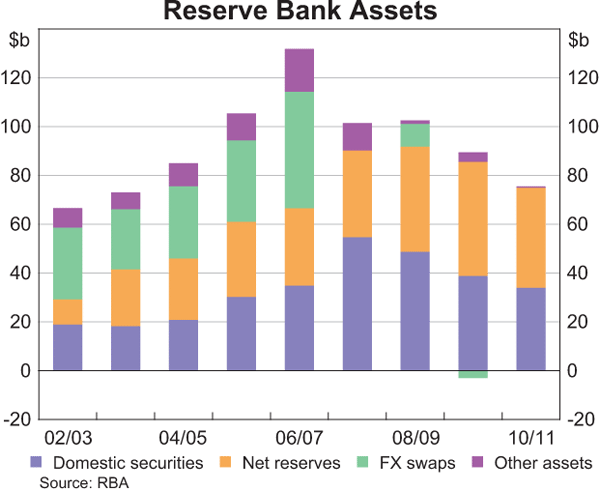
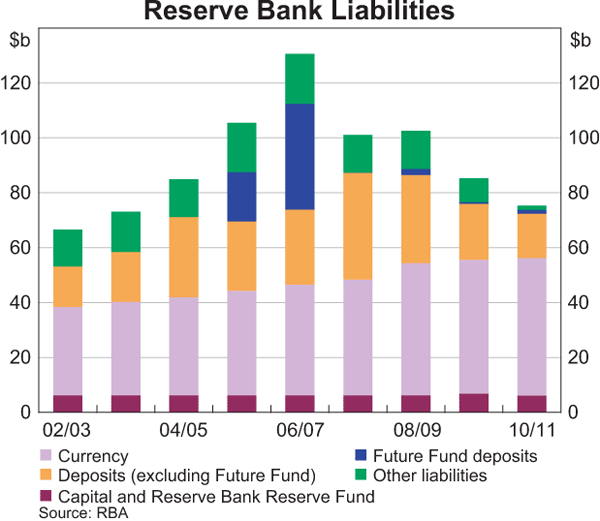
The Australian dollar value of net reserves declined by $5.7 billion over the year to $41.0 billion. The appreciation of the Australian dollar reduced the value of net reserves, in Australian dollar terms, by $6.1 billion. This was partially offset by interest earnings. There were minimal foreign exchange swaps outstanding at the end of June. As a result, the level of gross reserves, which is the level of net reserves adjusted for foreign exchange held or lent under foreign exchange swaps, also stood at $41.0 billion at the end of June.
Implementation of the Basel Committee on Banking Supervision's new global liquidity standard has the potential to affect the size of the Bank's balance sheet in future years. The standard, which will take effect from 1 January 2015, imposes stricter requirements for financial institutions' holdings of liquid assets. In most jurisdictions, these regulatory holdings will consist of government securities. However, in Australia the level of government and semi-government debt outstanding will be insufficient to satisfy required regulatory holdings, and the Bank has announced that it will offer a ‘committed secured liquidity facility’.
| June 2009 | June 2010 | June 2011 | |
|---|---|---|---|
| Assets | 103 | 86 | 75 |
| Foreign | 54 | 47 | 41 |
| – Net reserves | 43 | 47 | 41 |
| – FX swaps | 9 | −3 | 0 |
| – Other | 1 | 3 | 0 |
| Domestic | 48 | 39 | 34 |
| Liabilities | 103 | 86 | 75 |
| Deposits | 34 | 21 | 18 |
| Currency | 48 | 49 | 50 |
| Other (including capital) | 20 | 16 | 8 |
|
Source: RBA |
|||
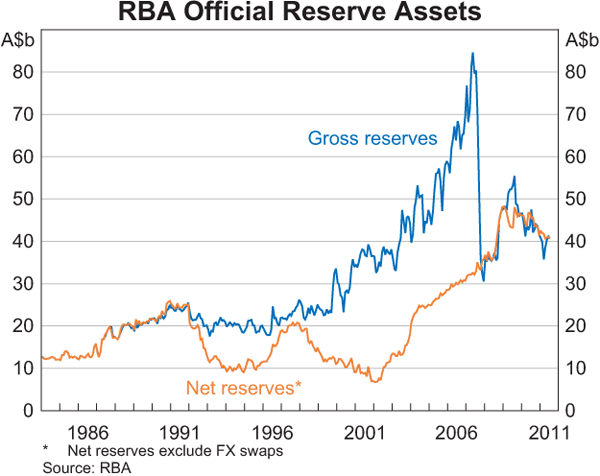
Authorised deposit-taking institutions (ADIs) will be able to establish, for the payment of a fee, a standing arrangement with the Bank that covers the shortfall between their liquid asset holdings and the regulatory requirement. In the normal course of events, the standing arrangement with ADIs would not affect the size or composition of the Reserve Bank's balance sheet. In the event that an ADI makes a call on its committed facility, however, the Bank's balance sheet would expand (other things equal). This is because the Bank would receive securities as collateral against the liquidity provided. Further details of the facility and APRA's prudential standard on liquidity risk management, which will give effect to the global liquidity framework in Australia, will be subject to consultation during 2011 and 2012. The facility is not expected to impair the Bank's ability to manage system liquidity or meet the Board's target for the cash rate.
Domestic Market Operations
To implement monetary policy, the Reserve Bank Board sets a target for the cash rate – the rate at which banks borrow and lend to each other on an overnight unsecured basis. To achieve the Board's target, the Reserve Bank operates in the market to maintain an appropriate level of exchange settlement (ES) balances. ES balances are liabilities of the Reserve Bank and are used by financial institutions to settle their payment obligations with each other and with the Bank. The Reserve Bank pays interest on ES balances at a rate 25 basis points below the cash rate target. Similarly, the Reserve Bank stands ready through a standing facility to lend cash overnight to financial institutions at an interest rate 25 basis points above the cash rate target. In general, the latter is only accessed by banks that have experienced unforeseen payments flows late in the day and are unable to readily source covering funds. This ‘corridor’ provides an incentive for ES account holders to recycle their balances within the market and means that, in normal times, aggregate ES balances are kept at low levels.
During 2010/11, the cash rate traded at target on all business days. The Reserve Bank's standing facility for overnight repos was accessed only twice, continuing a trend toward less usage over time.
| Number of times used | Value ($m) | |
|---|---|---|
| 2006/07 | 24 | 3,589 |
| 2007/08 | 18 | 4,220 |
| 2008/09 | 15 | 3,257 |
| 2009/10 | 5 | 1,035 |
| 2010/11 | 2 | 363 |
|
Source: RBA |
||
Payment flows each day between ES account holders and the Reserve Bank's customers (principally, the Australian Government) can alter the aggregate level of ES balances. As a result, the Bank needs to transact in the market on most days in order to offset the impact of its customer flows. For further details, see ‘Domestic Market Operations and Liquidity Forecasting’ in the Bank's December 2010 Bulletin. In the past year, unexpected liquidity flows saw the Bank conduct a second round of dealing on two occasions, the same as in the previous year.
Over the past year, aggregate ES balances averaged a little over $1¼ billion, with the Reserve Bank facilitating temporarily higher levels around key balancing dates in order to keep the cash market operating smoothly. While this is less than the level of balances held during the financial crisis, it is higher than the levels recorded before the crisis, reflecting a desire on the part of some ADIs to hold higher precautionary balances.
Most of the Reserve Bank's transactions within the domestic market are contracted as repos. Under a repo, one party agrees to sell a security to another with an agreement to repurchase the security at a future date at a pre-agreed price. In its market operations, the Reserve Bank is willing to purchase both government-related debt securities (‘general collateral’) and private debt securities under repo. To guard against a fall in the value of the security in the event that the counterpart to the transaction may not be able to repurchase their security at the agreed time, the Bank requires the value of collateral to be higher than the cash lent by some percentage of the security's initial price. These percentages range from 2 to 10 per cent, increasing with the risk profile of the security.
Over the past year, the value of securities held under repo has ranged between $20 billion and $35 billion as the balance sheet has fluctuated with the movements in Government deposits discussed earlier. In contrast to recent years, government-related securities now account for the bulk of securities held under repo. During the period of financial market turbulence in 2008 and 2009, many ADIs created securities backed by residential mortgages they were holding on their balance sheets and sold them to the Bank under repurchase agreement. Although highly rated residential mortgage-backed securities (RMBS) remain eligible for the Bank's market operations, the Bank expects ADIs to present related-party mortgages only in extraordinary circumstances.
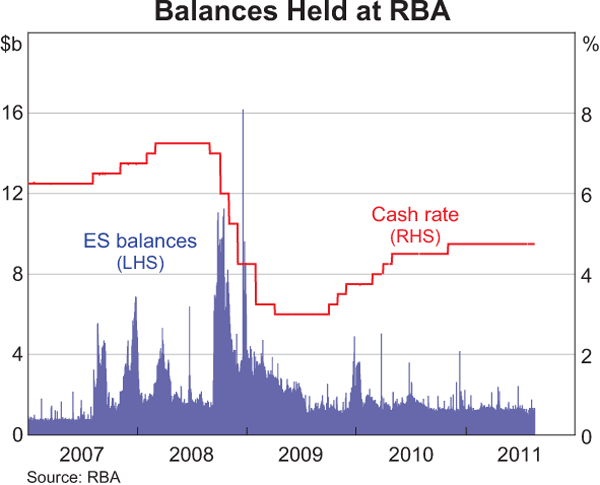
| June 2009 | June 2010 | June 2011 | ||||||
|---|---|---|---|---|---|---|---|---|
| $ billion | Per cent of total |
$ billion | Per cent of total |
$ billion | Per cent of total |
|||
| General collateral | ||||||||
| – CGS | 2.5 | 6 | 3.3 | 9 | 3.9 | 18 | ||
| – Semis | 1.2 | 3 | 10.8 | 31 | 8.7 | 41 | ||
| – Supras | 0.4 | 1 | 2.2 | 6 | 2.0 | 10 | ||
| – Government guaranteed | 0.3 | 1 | 5.6 | 16 | 4.0 | 19 | ||
| Private Securities | ||||||||
| – ADI issued | 11.8 | 28 | 8.8 | 25 | 1.2 | 5 | ||
| – RMBS | 26.1 | 61 | 3.6 | 10 | 1.5 | 7 | ||
| – Other | 0.2 | 0 | 0.5 | 1 | 0.0 | 0 | ||
| Total | 42.5 | 34.8 | 21.4 | |||||
|
Source: RBA |
||||||||
The average term of the repos contracted by the Bank in its market operations has been fairly stable during the past year at around three to four weeks, similar to its level prior to mid 2007. While the Bank remains willing occasionally to deal for longer terms, short-term repos generally provide the Bank with the appropriate degree of flexibility to manage its balance sheet.
In addition to repurchase transactions, the Reserve Bank is willing to purchase Commonwealth Government securities (CGS) and semi-government securities on an outright basis in its daily operations for domestic liquidity management purposes, provided those securities have a term to maturity not exceeding 18 months. Outright purchases of longer-dated government securities are transacted through separate, less regular, operations. During 2010/11, the Bank conducted five ‘long-dated’ operations, purchasing $100 million in semi-government securities each time. From time to time the Bank also purchases very small amounts of CGS at Australian Office of Financial Management (AOFM) tenders. At present, the Bank holds around $3 billion of longer-dated securities on an outright basis, almost all of which are semi-government securities.
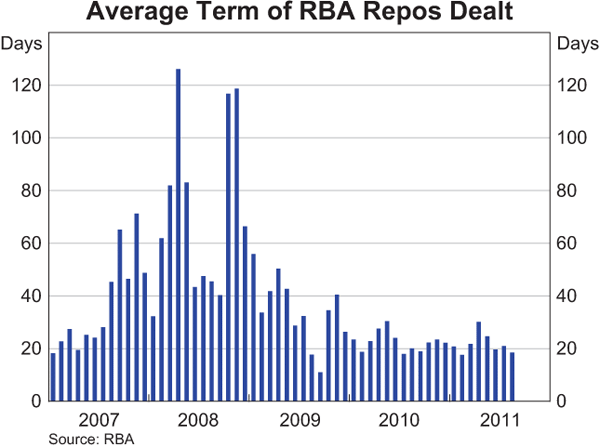
On behalf of the AOFM, the Reserve Bank operates a lending facility for CGS. This facility allows market participants to borrow specific lines of CGS via a repo with the Reserve Bank. An offsetting repo in other CGS or government-related securities is transacted at the same time. As the spread between the two repo rates is set at a significant penalty for the Bank's counterparty (300 basis points), the facility is used only as a last resort by dealers to avoid settlement fails. With liquidity in the CGS market having improved in recent years, dealers are almost always able to borrow stock without recourse to the facility. Consequently, usage of the AOFM facility has declined substantially, with only $1.3 billion of CGS lent during the whole of 2010/11.
Foreign Exchange Operations
The Reserve Bank is an active participant in the foreign exchange market. Most of its transactions are undertaken on behalf of the Reserve Bank's clients, mainly the Australian Government. The Government purchases foreign currency from the Bank to meet foreign currency obligations arising from certain defence expenditures, foreign aid commitments and the cost of maintaining its diplomatic missions around the world. In 2010/11, the Reserve Bank sold $7.4 billion of foreign currency to the Australian Government. In the normal course of events, the Bank offsets the sale of foreign currency to the Government in the market within a short time frame.
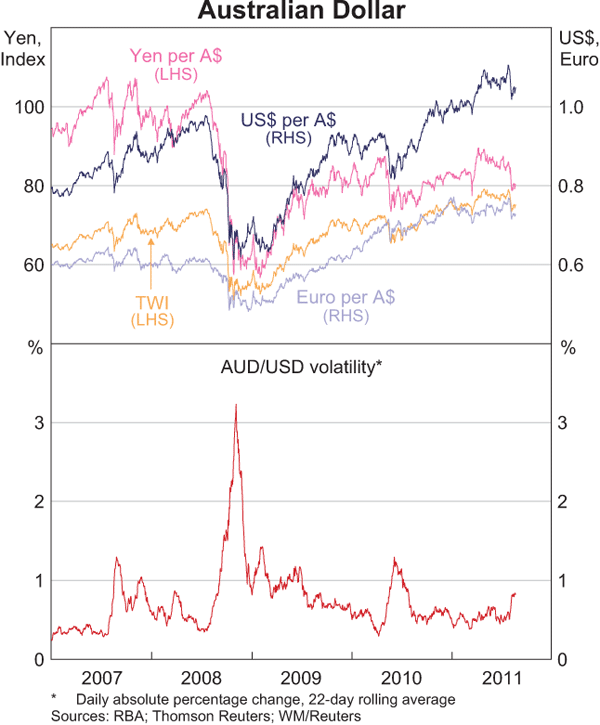
The Reserve Bank also operates in the foreign exchange market to manage its international reserves. The currency exposure of international reserves is managed to a benchmark that has fixed target shares for each foreign currency (see below). Daily fluctuations in the relative values of these currencies shift the actual exposures to these currencies away from the targets. The Bank undertakes transactions each day to rebalance the currency exposures to the benchmark targets. These transactions are conducted in both the spot and forward markets and do not involve the Australian dollar.
In addition, the Reserve Bank undertakes transactions from time to time for a range of policy reasons:
- Foreign exchange swaps are used periodically to smooth large domestic liquidity flows. These transactions work in the same way as repurchase agreements using domestic securities. The swaps can be for large amounts but are usually very short term. While turnover in these transactions totalled $50 billion for the year, the Bank had a negligible outstanding swap position at the end of June.
- On occasion, the Bank operates in the foreign exchange market with the objective of influencing the level of the exchange rate or market conditions. The factors behind the decision to conduct these operations, which are commonly known as foreign exchange intervention, tend to be specific to the particular episode. The most recent round of intervention took place in late 2008, when liquidity in the local foreign exchange market was compromised following the collapse of Lehman Brothers.
- From time to time, the Bank also undertakes transactions to adjust the level of its foreign currency holdings. These transactions might be undertaken to unwind the impact of intervention on the level of reserves or to move to a new target level. The transactions are conducted with the aim of having the minimum possible impact on the exchange rate and market conditions.
The Australian dollar appreciated against most currencies over the year but particularly against the US dollar. The local currency was underpinned by further increases in commodity prices, the relatively strong domestic economy and expectations of tighter monetary policy. In July, the Australian dollar reached a post-float high against the US dollar and on a trade-weighted basis. Despite bouts of risk aversion associated with the sovereign debt crisis in Europe and the earthquake in Japan, market conditions remained generally favourable. Volatility in the Australian dollar remained at an elevated level relative to pre-crisis years.
Reserves Management
The foreign currency assets and gold that are held on the balance sheet of the Reserve Bank comprise the major part of Australia's official reserve assets. The Bank has responsibility for the management of these assets, which are held primarily to facilitate policy operations in the foreign exchange market. As these assets expose the Bank's balance sheet to foreign currency risk, the level of reserves is managed to meet expected policy needs.
Given the policy roles of the reserves portfolio, the investment mandate under which it is managed places a high priority on the liquidity and credit quality of the assets in which the funds are invested. While portfolio return is an input to the management process, it is subordinated to limiting liquidity, credit and reputation risk. Reflecting this, the Reserve Bank has adopted a cautious approach to the management of the reserves portfolio. Under this approach, the risk profile of the funds under management is defined largely by a benchmark.
The benchmark is a hypothetical portfolio that represents the Reserve Bank's estimate of the optimal strategic allocation to foreign currencies, and the assets in which they are invested, given the policy objectives of the portfolio. The composition of the benchmark is reviewed periodically to take into account updated performance and credit data, any structural changes in financial markets and changes in the Bank's risk tolerance.
The most recent review of the benchmark was completed in 2010. This exercise reviewed the implications of the financial crisis for the composition of the benchmark and the Reserve Bank's investment framework more broadly. This process recommended a number of changes, which were implemented over 2010/11:
- The portfolio allocation to the Japanese yen was reduced from 10 to 5 per cent and an allocation of 5 per cent to the Canadian dollar was established. This change took into account updated performance data across a range of currencies as well as the results of portfolio tail-risk analysis.
- The benchmark duration target for the Japanese portfolio was reduced from 18 to 12 months. This decision followed a reassessment of the risk/return trade-off in the portfolio given the level of yields and the shape of the yield curve in Japan.
- The benchmark allocation to commercial bank deposits was removed and the Reserve Bank's use of such deposits was reduced to a minimum. This decision reflected a reassessment of unsecured credit exposures in the portfolio. This review took into account the contribution of such exposures to portfolio return, the availability of alternative secured-cash investments and the potential difficulties for central banks posed by exposures to commercial banks at times of market stress.
| US | Europe | Japan | Canada | |
|---|---|---|---|---|
| Asset allocation (% of total) | 45 | 45 | 5 | 5 |
| Currency allocation (% of total) | 45 | 45 | 5 | 5 |
| Duration (months) | 18 | 18 | 12 | 18 |
|
Source: RBA |
||||
Over 2010/11, the return on foreign currency assets, measured in Special Drawing Rights, was 1.8 per cent, the lowest annual return since 2005/06. The low return was mainly due to the very low level of global bond yields; the net capital gain on holdings of securities was negligible. The higher average Australian dollar exchange rate over the year reduced the Australian dollar value of foreign earnings by 17 per cent.
| US | Europe | Japan | Canada | |
|---|---|---|---|---|
| 2004/05 | 4.1 | 5.8 | 1.1 | na |
| 2005/06 | 1.2 | 0.1 | −0.9 | na |
| 2006/07 | 5.6 | 2.2 | 1.1 | na |
| 2007/08 | 8.1 | 4.0 | 1.7 | na |
| 2008/09 | 5.2 | 8.1 | 1.8 | na |
| 2009/10 | 2.3 | 2.7 | 0.8 | na |
| 2010/11 | 1.1 | 0.4 | 0.2 | 1.0 |
|
Source: RBA |
||||
The Reserve Bank also maintains a modest allocation of funds to two regional bond funds: Asian Bond Fund 1 and Asian Bond Fund 2. These funds are part of the Asian Bond Fund Initiative, which was established by the Executives' Meeting of East Asia-Pacific Central Banks (EMEAP) to assist in the development of local currency bond markets in the region. The Bank has a total of $383 million invested in these funds. The return on these investments over 2010/11 was 8.8 per cent measured in US dollar terms. The two funds are passively managed by external managers.
In addition to foreign currency assets, the Reserve Bank holds 80 tonnes of gold on its balance sheet. Over 2010/11, the price of gold rose by 21 per cent in US dollar terms but declined by 4 per cent in Australian dollar terms. As a result, the value of the Bank's holdings of gold declined slightly to $3.6 billion at the end of June. The lack of activity in the gold lending market, noted in recent annual reports, continued in 2010/11. Reflecting this, income from gold lending fell to just $0.1 million for the year and, at the end of June 2011, there was only 1 tonne of gold on loan.